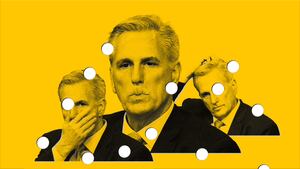A painting? That’s it?
Without intending disrespect or blasphemy, as a practicing Muslim I’d like to think that’s how the Prophet Muhammad would respond to the latest controversy surrounding the use and depiction of his image.
As reported in The Daily Beast last week (and later in The New York Times), at Hamline University—a small, private university in Saint Paul, Minnesota—a Muslim student objected when adjunct professor Erika Lopez Prater showed a 14th-century painting of the prophet in her global art history class— but only after the professor had given students numerous opportunities to raise concerns or ask to be excused from this particular presentation.
Before introducing the painting in her class, Prater had proactively noted on her syllabus that the material was sensitive and asked students to contact her in advance with any potential concerns. No one did.
After the fact, a single Muslim student, later joined by several other Muslim students at the university, complained to the university administration about the professor creating an Islamophobic environment. Most Muslims believe it is blasphemous to show pictorial representations of the prophet, even though there is disagreement of opinion among the community of 1.8 billion Muslims globally.
In a matter of weeks, Hamline rescinded Professor Prater’s offer to teach the following semester. About a month after the lecture, an all-employee email was sent describing the classroom exercise as “undeniably inconsiderate, disrespectful, and Islamophobic.”
All this over a 14th-century painting?
The prophet could tolerate a painting.
Muhammad was mocked, ridiculed, humiliated, assaulted, and hunted by his own clan and family members. The prophet survived numerous assassination attempts, including a poisoned roasted sheep offered to him. His former allies and neighbors routinely threw piles of intestines, human feces, and blood on his doorstep as a reminder of what they thought of Islam and his monotheistic teachings which upended their pagan rituals and norms.
His uncle’s wife would collect thorny branches and deliberately place them on his daily path. The people of Ta’if, a city close to his hometown of Mecca, responded to this message by ordering their children to throw stones at him until his shoes became filled with blood. And there was Hind, a woman whose hatred of the prophet was so intense that she assassinated his beloved uncle, mutilated his body, and took a bite of his liver. Eventually, the persecution forced the prophet and his companions to flee their homes and seek refuge in the neighboring city of Medina. (President Donald Trump, who promised a Muslim ban during his initial campaign and said “I think Islam hates us,” had nothing on the original Islamophobes.)
In his time, the prophet’s disrespectful critics were just as, if not more, hateful than the bigots Muslims confront in the U.S. and Europe today.
But he could take it.
In all those instances, he never retaliated with violence. He picked up the animal refuse from his doorstep and simply threw it away. He held out hope for the people of Ta’if and prayed for them. The woman who tried to feed him poisoned sheep? He forgave her, just like he forgave his former Meccan oppressors, including Hind.
He didn’t issue fatwas commanding his followers to attack his abusers, or to try to silence writers like Salman Rushdie simply because he once wrote a work of narrative fiction that used Islamic characters and tropes. He didn’t order assassins to enter the homes and buildings of his fiercest critics and slaughter innocent people indiscriminately while yelling “Allahu Akbar."
With his actions as our template, do you think he’d support the punishment of an adjunct professor who shared a well-known and celebrated painting of him as a means of educating students about the diversity of Islamic artistic expression and thought? Would her actions be considered “undeniably inconsiderate, disrespectful and Islamophobic” even though she went out of her way to be undeniably considerate and respectful to her Muslim students?
We don't know what Prophet Muhammad would say, but Muslims speak, and we can listen to them.
In my WhatsApp chats, my Muslim friends just shook our heads in disbelief when we read about the controversy and immediately sided with Professor Prater. The Muslim Public Affairs Council (MPAC), a Muslim-American organization, issued a statement of support for the professor and urged “the university to reverse its decision and to take compensatory action to ameliorate the situation.” Muslim-American professors, including those who take their Islamic faith seriously and adore the Prophet Muhammad, are among the 13,000 signatures on a petition to support Prater.
The petition further warns that the “university’s statements and actions in effect privilege a small group of individuals while silencing and possibly discriminating against many faculty, staff and students, both Muslim and non-Muslim.” Their point is straightforward, given the circumstances, the freedom of academic inquiry can’t be sacrificed because of a few individuals.
But beyond that, the university’s cowardly response is bad for Muslims—even those who believe that images of the prophet are blasphemous—who might be scapegoated as intolerant reactionaries due to the absurd actions of a few. The Hamline students who complained are young, and shouldn’t be vilified, but it should be clear that they don’t speak for me or for many Muslims in America.

Hamline University in St. Paul, Minnesota.
McGhiever/Wikimedia CommonsAt a time when universities are facing bad faith attacks from right-wing political forces as so-called bastions of woke indoctrination and cancel culture, Muslims can play a role in revealing the fine balance between proudly practicing one’s faith while living in a pluralistic, secular society.
Muslims shouldn’t fall for the overused and overwrought cries that every campus speech controversy is simply “wokeness” run amok. We must not allow a sensitive religious issue—even one that involves maintaining respect for the prophet—to turn into a performative overreaction by Hamline University. Being Muslim requires faithfulness, but not censorship of scholarship. It requires defending our beliefs, but not being afraid of having those beliefs challenged, especially in a secular country that also celebrates religious freedoms.
And this incident is harmful to Hamline students who won’t be exposed to the rich, complex tapestry of Islamic thought and art that shatters the reductive, monolithic stereotypes that often dominate Western discourse about the world’s second-largest religion. A better and more educational response by the aggrieved Muslim students could have been asking the professor to discuss with the class why many Muslims believe in prohibiting displaying pictorial images of the prophet.
Finally, the irony: The students’ complaint and the administration’s knee-jerk response ultimately didn’t elevate, beautify or protect the dignity and honor of the Prophet Muhammad—not in my book. Instead, they missed the plot. If they can’t tolerate seeing a painting of him, then I recommend they open a book and read about how he engaged with his fiercest enemies and critics.
If they can't take it, then at the very least they can learn to give mercy and second chances.









